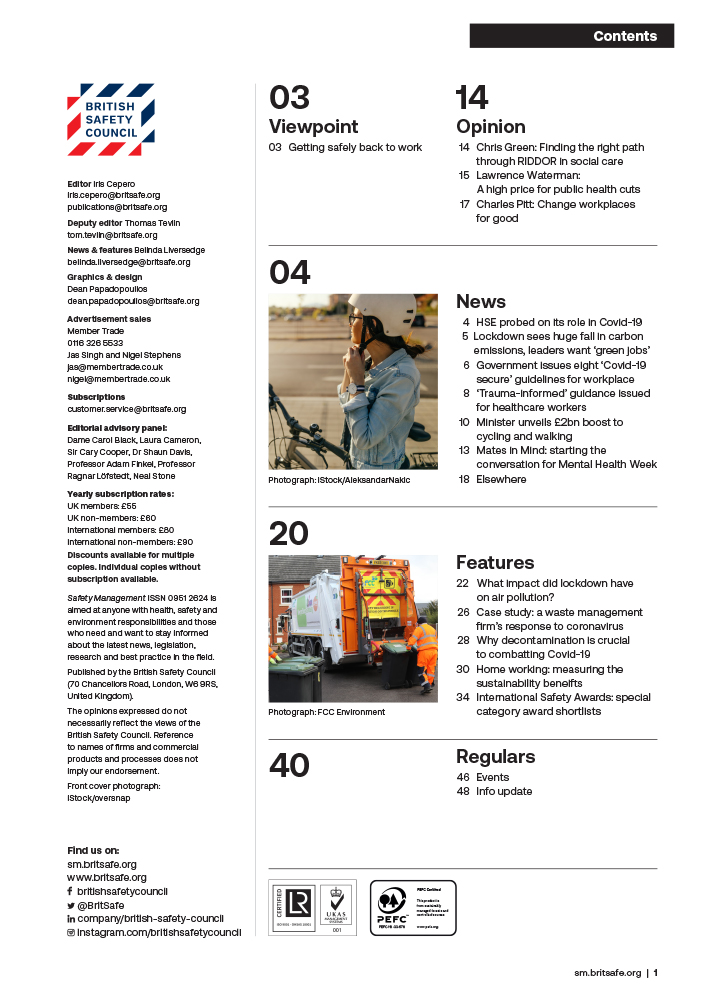From working alone to commuting after hours, workers can be vulnerable to threats, aggression and harassment – but training and the right technology can help.
Features
Vulnerable workers: protection is key
The health, safety and wellbeing of lone and vulnerable workers should be a top priority for all organisations. Whether employees are working remotely, in the field, or during unsociable hours, the risk of violence, abuse and harassment remains prevalent.
These risks can have serious consequences – not only for the individuals affected, but also for the organisation as a whole, including potential liabilities, damage to reputation and loss of talent. Recognising and addressing the unique vulnerabilities of these workers is crucial in ensuring their safety and wellbeing.
 Photograph: Peoplesafe
Photograph: Peoplesafe
Identifying vulnerable workers
Before you can implement measures to mitigate risks to lone and vulnerable workers, it’s important to establish who falls under these categories within your organisation. The Health and Safety Executive (HSE) defines lone workers as “those who work by themselves without close or direct supervision”. As of 2022, HSE guidance includes employees who work from home. Due to the cultural shift towards hybrid working, a large section of the workforce now spends a considerable percentage of time working from home, bringing this sector of workers into the consciousness of more employers than ever before.
Vulnerable workers include lone workers but may also include those who are at a higher risk due to factors such as their age, pre-existing medical conditions or the nature of their work.
To identify lone and vulnerable workers, organisations should conduct a thorough assessment of job roles, work environments and individual circumstances. Look for employees working in isolated locations out of sight or earshot of others, employees performing late-night shifts or those engaging in tasks that involve interactions with the public. By recognising the increased vulnerabilities among these employees, organisations can tailor their safety measures to address their specific needs and ensure the wellbeing of all workers.
Improving health and safety
To ensure the wellbeing of vulnerable workers, organisations must undertake comprehensive measures to mitigate risks and create a secure work environment.
The starting point should be conducting a thorough risk assessment to identify potential hazards caused by the nature of the work, the environment in which it is conducted and any specific vulnerabilities that employees may have. By taking a proactive approach to risk management, employers can create safer work environments and reduce the likelihood of accidents or incidents occurring.
Once risks have been identified, it’s crucial to implement appropriate safety measures to protect vulnerable workers. This may involve physical modifications to the work environment, such as installing security barriers or shields, providing additional personal protective equipment or implementing personal safety technology.
 Photograph: Peoplesafe
Photograph: Peoplesafe
Training is another essential component of improving the health and safety of lone and vulnerable workers. Leveraging expertise from industry leaders like the Suzy Lamplugh Trust to provide comprehensive training in areas such as de-escalation techniques, conflict resolution strategies and dynamic risk assessment equips employees with the skills and knowledge they need to effectively manage challenging situations. By empowering workers to take responsibility for their own personal safety, recognise potential risks and respond appropriately, organisations can significantly reduce the likelihood of incidents occurring.
In addition to training, the implementation of specific policies and procedures can further enhance safety measures. These should be developed with the unique needs of vulnerable workers in mind. For instance, implementing a buddy system where workers regularly check in with each other can provide an additional layer of security. Likewise, utilising online diaries or scheduling tools allows organisations to track employees’ expected locations, offering the chance to issue alerts if they do not return from a scheduled appointment as planned.
Once the risks have been identified and safety measures have been implemented, it’s essential to continuously improve these measures to ensure their ongoing effectiveness. By establishing a culture that encourages feedback from workers, organisations can learn from valuable insights and frontline experiences of their employees. This feedback can then be used to identify areas for improvement, address emerging risks and refine safety protocols.
Utilising technology for risk reduction
Personal safety technology can also play a pivotal role in reducing the risk of violence, abuse and harassment for lone and vulnerable workers. Within the employee safety sector, a suite of solutions are now available, including wearable devices, mobile applications and body-worn cameras (BWCs), offering real-time monitoring and emergency response capabilities.
 Naz Dossa is chief executive of Peoplesafe. Photograph: Peoplesafe
Naz Dossa is chief executive of Peoplesafe. Photograph: Peoplesafe
This tech is linked directly to a 24/7/365 professional monitoring service, on hand to handle emergencies quickly and efficiently. One of the key advantages of these solutions is their ability to provide faster response times than traditional emergency services. Leading organisations in this sector, like Peoplesafe, are equipped with Unique Reference Numbers, which provide direct access to police control rooms, bypassing the 999 system in an emergency.
Some technologies also incorporate features such as personal profiles containing critical information, escalation plans and GPS location tracking, which enable incidents to be resolved rapidly in crisis situations, potentially saving lives.
Adaptable to the unique requirements of each organisation, these technologies can provide versatile support. In certain instances, they can offer discreet assistance in scenarios where overtly calling for help might exacerbate the situation – for example, a housing officer delivering bad news to a difficult tenant.
However, they can also be clearly displayed to serve as a deterrent, particularly in public-facing roles in industries like retail, healthcare and transport. This has proved particularly effective with body-worn cameras which have reduced incidents of assault by 47 per cent according to research by the Rail Delivery Group, British Transport Police and the University of Cambridge.
Tailored safety features
These technologies offer a range of features designed to address the diverse needs of lone workers across disparate industries. For example, for those working in high-risk roles, timed activities allow users to set expected durations for their tasks and receive welfare checks at designated intervals, with an automatic alarm raised if safety checks are not confirmed.
Voice memos provide another layer of functionality, enabling users to leave additional information about their tasks or surroundings. These memos can offer context to responders in case of an emergency, aiding in swift and informed decision-making. Additionally, fall detection capabilities serve as a failsafe measure, automatically signalling for assistance in the event of a slip, trip or fall. This feature provides peace of mind, knowing that help will be promptly dispatched even if the user is unable to trigger an alarm manually.
These features can be tailored to suit the specific needs of employees, departments and organisations, offering versatile support solutions that prioritise safety and wellbeing.
Proactive communication and support
Effective communication is essential in reinforcing safety protocols and encouraging the consistent use of safety measures among vulnerable workers. Mass notification systems can be used to inform employees of emerging threats in their work environment and remind them to utilise the safety services provided.
Some of these platforms also allow organisations to customise communication channels based on the preferences and requirements of their workforce. Whether it’s through SMS, email or push notifications on mobile devices, employees can receive alerts in a format that ensures prompt attention and action, keeping them informed of vital information.
Safety beyond 9–5
Many forward-thinking employers are recognising the increasingly blurred boundaries between work and personal life, prompting them to prioritise the safety of lone and vulnerable workers beyond traditional working hours.
Employers are confronted with the reality that those working from home may face heightened risks, particularly in instances of domestic abuse or pre-existing medical conditions, as employers often no longer have the ability to physically see employees to ensure their wellbeing. This means they must adapt and implement new strategies to fulfil their duty of care towards employees, regardless of their work location or hours.
Research conducted by Peoplesafe¹ sheds light on the pervasive safety concerns among employees, finding that 72 per cent have safety concerns when hybrid working. This heightened sense of vulnerability is exacerbated during commuting hours, where 60 per cent of respondents report feeling unsafe, especially during unsociable hours.
Recognising the need for a comprehensive approach to employee safety, leading organisations are turning to 24/7 employee safety services to protect employees at home, on their commute and in their personal lives. This proactive stance not only fulfils the moral obligation but also aligns with employees’ expectations, as 51 per cent of people questioned for the research believe their employer has a duty of care towards them outside of working hours.
One example of such initiatives is Dignity, a leading funeral services provider that has taken proactive steps to prioritise the wellbeing of its workforce. By equipping every employee with access to a personal safety app, Dignity ensures that its employees can access professional personal safety protection whenever and wherever they need it.
It’s also crucial for employers to acknowledge that harassment from customers and service users can, and often does, extend beyond work. Instances of harassment outside of work can lead to increased levels of stress, anxiety and fear among employees, affecting their mental health and overall sense of safety. Therefore, it’s imperative for employers to take proactive measures to address and mitigate the risks of harassment, regardless of when or where it occurs.
Dave Pardoe, head of profit protection at The Works, a major UK retailer of art and craft materials, books and toys, emphasises the need for continuous support, stating: “The relationship we have with our staff is not a 9–5 thing. One of our staff has been at risk of harassment from a customer who has targeted them outside of work and we will look to provide them with a device or app to provide that level of protection.”
By embracing proactive strategies, from robust risk assessments to cutting-edge technology solutions, employers can not only meet their legal obligations but also demonstrate a commitment to their employees’ safety and wellbeing. This commitment fosters a loyal and engaged workforce, making the prioritisation of employee safety not just the right thing to do, but a strategic investment in productivity and business growth.
Naz Dossa is chief executive of Peoplesafe.
For more information see:
T: 0800 990 3562
References
1. peoplesafe.co.uk/whitepapers/overcoming-the-employee-safety-gap/


FEATURES

India’s path to net zero: a work in progress
By Orchie Bandyopadhyay on 08 April 2025
India is implementing a variety of clean energy measures to hit its target of net zero greenhouse gas emissions by 2070, including plans to rapidly scale up the generation of nuclear power. However, climate experts say significant finance will be required from developed countries to phase out coal power, accelerate renewables deployment and expand the national electricity grid.

Too hot to handle: early arrival of heatwaves in India sparks calls for action to protect workers and the public
By Orchie Bandyopadhyay on 08 April 2025
Temperatures in India in February 2025 were the hottest since records began over a century ago, prompting warnings the country needs to urgently step up efforts to protect both workers and the general population from the health risks posed by extreme heat and humidity.

